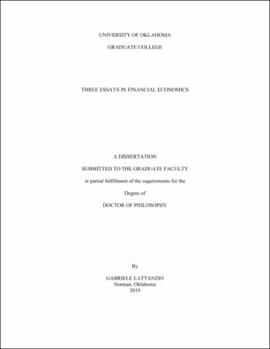| dc.description.abstract | This dissertation comprises three essays. The first reports a macro-economic application of the synthetic control method developed in Abadie and Gardeazabal (2003) to assess the economic implications of the institutionalization of social norms within a country’s legal framework. In the second essay I develop and applied the same methodology to assess the financial and social welfare implications of megamergers completed in the U.S. over the period 1979-2014. The last essay investigates whether the restructuring gains achieved by state owned enterprises (SOEs) over the three years preceding their attempted privatizations can be sustained absent the ownership transfer from political investors to profit maximizing investors.
The macroeconomic and macro finance literature have established that religious and cultural practices have major implications for a Country’s economic performance. However, it is not clear if the institutionalization of these social norms within a country’s legal system causes material economic effects. In Chapter 1 I show this to be the case. By employing a case study approach to mitigate endogeneity concerns, I show that the institutionalization of Sharia Law within a Muslim-majority country’s legal system causes material economic costs. Results hold in different settings, confirming that the governmental enforcement of existing social norms constrain individuals’ social and economic freedom, ultimately resulting in worsened economic outcomes.
In Chapter 2 I build upon the methodology described in Chapter 1 to assess the financial and social welfare implications of the megamergers completed in the U.S. over the period 1979-2014. It is indeed challenging to develop a plausible counterfactual for identifying merger synergies because the merged firm is fundamentally different from the two merging firms and targets’ separate accounting information is no longer available. The synthetic controls method allows to address these issues and to assess the economic consequences of 383 domestic mega-deals. Merging firms’ sales-based performance improves following a merger, but find mixed results for their asset-based performance. This inconsistency originates from merged firms subsidizing their inefficiencies by charging higher markups. Consistent with the quiet life hypothesis, insiders capture most of the economic rents and consumers’ welfare appears to be negatively affected.
In Chapter 3 I employ a novel, hand-collected sample of withdrawn and completed share issue privatizations (SIPs) to show that both groups undergo comparable restructuring processes over the three years preceding the event. By relying upon a matching procedure to explicitly control for the identified restructuring effect, I isolate the ultimate consequences of the ownership transfer from state to private investors on corporate policies and performance. I find that, absent the ownership transfer, most of the gains realized during the restructuring process are re-absorbed over the post-treatment period. Results are robust to the use of instrumental variables, indicating that the transition from state to private ownership represents a necessary condition for the long-term success of privatization programs. | en_US |
